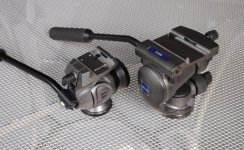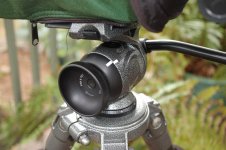henry link
Well-known member
I just received my Gitzo GH2720QR head and wanted to report some initial reactions even though I haven't had time for much testing.
Certainly the most controversial aspect of this design is its very limited drag adjustment. The big knob on the side twists to lock and unlock both pan and tilt together. The fully unlocked position appears to be intended as a "one size fits all" drag setting. It actually seems to work pretty well over a very wide range of scope weights which would include even the heaviest birding scopes. A little extra drag can be applied before the head locks but the motion becomes increasingly sticky and jerky especially for the pan function which can't be adjusted separately.
The obvious disadvantage in such an idiot proof arrangement is that the user is unable to tweak the drag settings for personal preferences. For instance, I would prefer slightly less pan drag and a little more tilt drag but as far as I can tell there's no way to achieve it. One other disadvantage for my purposes that include casual astronomy is that the fixed tilt drag setting is not quite sufficient to prevent even my lightest, shortest telescope (4 pounds, 16") from slowly flopping at very high and low tilt angles much beyond 45 degrees. High elevation sky views need extra tilt drag, but that makes the pan motion too sticky. Of course it's possible to rebalance the scope with the sliding QR plate for high elevation views and shorter, lighter birding scopes should do better.
The build quality is typical Gitzo and so far the head appears to be quite vibration free. Rapping the tripod, head and scope at various spots produced only a small amplitude quick oscillation which dissipates in less than 0.5 seconds.
As time allows over the next week I'll try to do some field testing and comparisons to other heads I have around like the Gitzo 2380 and Manfrotto 128LP.
Certainly the most controversial aspect of this design is its very limited drag adjustment. The big knob on the side twists to lock and unlock both pan and tilt together. The fully unlocked position appears to be intended as a "one size fits all" drag setting. It actually seems to work pretty well over a very wide range of scope weights which would include even the heaviest birding scopes. A little extra drag can be applied before the head locks but the motion becomes increasingly sticky and jerky especially for the pan function which can't be adjusted separately.
The obvious disadvantage in such an idiot proof arrangement is that the user is unable to tweak the drag settings for personal preferences. For instance, I would prefer slightly less pan drag and a little more tilt drag but as far as I can tell there's no way to achieve it. One other disadvantage for my purposes that include casual astronomy is that the fixed tilt drag setting is not quite sufficient to prevent even my lightest, shortest telescope (4 pounds, 16") from slowly flopping at very high and low tilt angles much beyond 45 degrees. High elevation sky views need extra tilt drag, but that makes the pan motion too sticky. Of course it's possible to rebalance the scope with the sliding QR plate for high elevation views and shorter, lighter birding scopes should do better.
The build quality is typical Gitzo and so far the head appears to be quite vibration free. Rapping the tripod, head and scope at various spots produced only a small amplitude quick oscillation which dissipates in less than 0.5 seconds.
As time allows over the next week I'll try to do some field testing and comparisons to other heads I have around like the Gitzo 2380 and Manfrotto 128LP.





